If you want to know about quilting, Frances Arnold is your woman.
Arnold, who has been quilting for 34 years, has seen some ups and downs. She can tell you about the United States Bicentennial in 1976, which sparked a renewed interest in an art form that had been well on the decline. She can tell you about the Recession that started in 2007, which caused the removal of classes that taught sewing from schools facing drastic budget cuts.
It’s true that a good portion of any given quilting community is going to be affluent women of retirement age— people who have the time to invest in a long-term project, money to afford materials like fabric and sewing machines and interest in a craft typically seen as both feminine and antiquated.
But younger generations are also patching in. There is a significant subset of quilters under the age of 45 who find time for stitches in between their full-time jobs and other obligations. And perhaps nobody is more excited about encouraging their practice than Arnold, a quilter from Watkinsville.
Arnold can also tell you how to quilt — in fact, she’s more than happy to do it.
All About Quilting
Before I sat down with Arnold in her home to interview her about her lifelong passion, I asked one important question that I really did not know the answer to: how does quilting work?
I followed her to her upstairs workroom, a small space with quilts hanging on the walls and containers of fabrics going from floor to ceiling. The table in the middle was big, with plenty of elbow room, even decorated as it was with scraps of fabric and partially-assembled soon-to-be-somethings.
In answer to my question, Arnold quickly appropriated some of those scraps — little one-inch triangles — and began to arrange them in front of me.
She showed me flying geese and a cat in a corner — which were not real animals, but “blocks.” Blocks are small patterns assembled from even smaller fabric scraps, which are then sewn together with any number of other blocks to make a quilt pattern.
“We take big pieces of fabric, we cut them into little pieces of fabric, and then we sew them back together to make big pieces of fabric,” Arnold said with a laugh. “That’s what my husband says I’m crazy to do.”
But for Arnold, quilting is a common thread she shares with her mother, grandmother, and great-grandmother: she comes from a long line of quilters.
Her mother was a traditional quilter— she did every stitch by hand, including the stitches that turn blocks and batting into a “quilt sandwich,” as Arnold describes it.
https://gradynewsource.uga.edu/blog/2016/05/04/crafting-with-heart-at-sunday-best-quiltworks/
Arnold showed me a spacious closet in a spare bedroom completely full of quilts, all neatly folded into squares. Her fingers hovered over the folded edges as she scanned them like a librarian searching a bookshelf.
Arnold pulled out the first quilt her mother ever made, hand-stitched when her mother was eleven. It’s a simple patchwork quilt, made out of whatever fabrics she had access to — which, to be sure, weren’t the luxury cottons you can get in fabric stores today — and sewn into a checkerboard pattern, dark blue against cream. Regardless of its age, and of the fact that its creator had never made a quilt before, the stitches still hold.

Comparing an artist’s early works to later ones can reveal a lot about the development of their skill and interests. So, I was delighted when Arnold unfolded another quilt her mother had created.
The pattern is called a broken star.
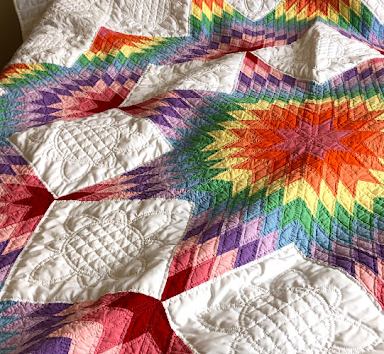
It looks like an exploding rainbow, starting with tiny red diamonds in the middle of the star and moving outwards through the color spectrum to the outside of the star. It’s a display of skill and dedication from a woman who was, by Arnold’s account, a lifelong and passionate practitioner.
But Arnold didn’t learn quilting from her mother.
Every quilt took her mother a year or more to make by hand, Arnold said, and that just didn’t appeal to her.
“I want to start it, finish it, move on to something else,” Arnold said. As a result, she didn’t pick up quilting until, while living in Australia, she found a friend who taught quilting classes.
Arnold learned hand-quilting, her mother’s preferred technique, during those lessons. Unlike Arnold’s mother, her teacher did smaller projects that didn’t take a year or longer to finish.
“It was like, okay, that’s doable to me,” Arnold said. “But what I say is, [my mother] gave me a love of creating things with your hands.”
Arnold shares that love with the other members of the Cotton Patch Quilters’ Guild.
Arnold was chairwoman of the Cotton Patch Quilters’ Guild’s annual Quilt Show at the Oconee Civic Center in March, which featured more than 200 quilts. She was delighted to report that they broke attendance records from previous years, finally surpassing 1,000 ticket sales.
This year, they sold 1,232 tickets. Arnold paid for the 1,000th guest.
“I took great pleasure in buying that ticket myself,” she said.
Quilts on Display
Arnold met me at the entrance to the Oconee Civic Center to let me into the show. She was extremely busy during the event, and was whisked away to handle something important shortly after encouraging me to take as many pictures as I needed.
But, I later learned from a vehement and slightly irate vendor that pictures are not always so welcome at quilt shows. Copyright infringement of original quilt patterns is common, and it starts with someone sneaking a picture of an artist’s original design. Later the design is recreated by someone else, who may falsely claim it as their own, resulting in outrage.
Uncomfortable as the lesson was, I made sure to thank the vendor for the warning.
The quilts at the exhibit showed stunning variety in subject matter, use of pattern and color, skill and the sizes of the final products.
Some of the quilts were made using traditional block patterns. Frequently they featured a “twist,” considered unusual for more conservative quilts, such as a more modern use of color or pattern.

Some of the quilts on display were modern, which, for quilters, means the patterns feature the use of negative space and vibrant color.
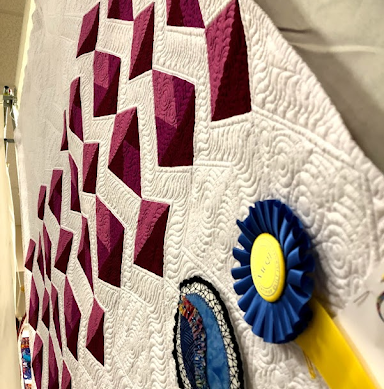
Some of the quilts were just unexpected.

Locally, the modern quilting movement may best be represented by Sylvia Schaefer, a quilt hobbyist — and oceanographer — who sells quilt patterns through her business Flying Parrot Quilts.
Schaefer had a vendor booth at the quilt show where she personally sold patterns, quilt kits, and copies of her most recent book, The Quilter’s Negative Space Handbook.
“I think that the modern aesthetic really appeals to a lot of younger people,” said Schaefer.
According to the Modern Quilt Guild, modern quilting is identified by the use of bold colors and prints, high contrast and solid color, minimalism and expansive negative space.
Modern quilting is “largely inspired by mid-century modern art and architecture,” said Schaefer. “Cleaner lines, brighter colors.”
The movement also features a certain amount of “modern traditionalism,” or updating traditional classic quilt designs with a modern twist.
“It’s about teaching people to take traditional quilt blocks and incorporate negative space into their quilt designs,” Schaefer said.
Schaefer is unique among modern quilters for her fondness for depicting scientific subjects. She sells patterns featuring microscopes, chemistry beakers, and bugs. At the quilt show, one of her pieces on display was a decorative wall quilt with the words “dinosaurs are for girls” on it.
“I’ve always been crafty and artsy, and there’s actually a lot of overlap with science and art,” Schaefer said. “You have to be creative in science to come up with ways to solve problems.”
Schaefer, in addition to her work as an oceanographer, author, and quilter, also teaches the occasional class on quilting — most recently, her “Block of the Month” class at Sew Sew Studio.
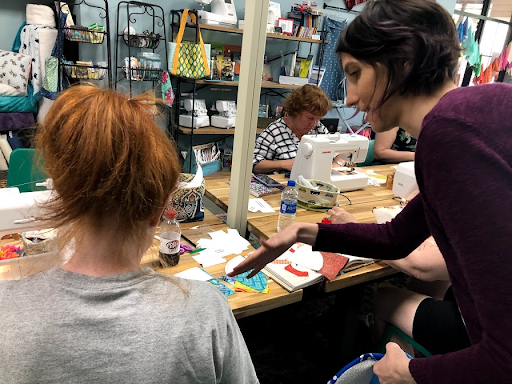
It’s All Sew-Sew
Sarah Campbell, owner of fabric store Sew Sew Studio, prides herself on catering to the younger, more modern crowd.
Campbell started her business from her home, selling nursery decorations on Etsy during her time as a stay-at-home mom.
“I kept waiting and waiting for somebody to open the kind of fabric store that I wanted to have here in town, and nobody did,” said Campbell. “It turned into the idea that I should do it.”
The kind of fabric store that Campbell wanted to have is a large rectangular space in the Franklin Grove shopping center, off of the Monroe Highway in Bogart, Georgia. The first thing you notice about it is the decor.

Multi-colored squares of fabric hang from pins on a line of clear twine, arranged to create a rainbow wave in the store’s tall windows. It’s a fun and creative display, and very representative of the modern quilting movement’s play with color and form.
Sew Sew Studio doesn’t just sell fabric. Campbell makes a dedicated effort to cater to beginners: people who don’t own a sewing machine, or who have never even touched one. In Campbell’s studio they can take project-based classes that let them learn to sew and bring home a finished product.
“We’re becoming more of a maker society,” Campbell said. “A lot of our generation is very interested in doing some sort of craft.”
But sewing, Campbell thinks, is intimidating because learning to sew can require a really hefty monetary investment: a sewing machine.
Certainly prices for sewing machines can range from $200 to $2000 — and up, depending on the features and attachments included. That’s nothing to sneeze at. And if you want to actually use it, you have to buy materials like thread and cloth as well.
Sew Sew Studio was created from the intersection of Campbell’s desires to sell modern fabrics and to make beginning a craft a little easier on the wallet.
“All you have to do is walk in the door,” Campbell said. “We have the machines, all the tools, everything.”
Campbell hopes the access to tools, and the variety of available classes, will encourage potential crafters, young and old, to start something new.
“It’s been a really great learning experience,” said Andrea Morillo, a 23-year-old textile design student at the University of Georgia, works at Sew Sew Studio. In addition to cutting fabric and taking inventory, Morillo also teaches some of the classes at the studio.
“I’m not, like, the greatest sewer,” Morillo said. “But I do enjoy getting to help the kids.”
Kids, Campbell says, are ideal beginners because they’re not “too particular about it being perfect. They’re not super bummed when something doesn’t line up on their first project.”
Campbell’s 7-year-old daughter began learning to sew as recently as last year, when Sew Sew Studio first opened. Now Campbell has her daughter do demonstrations for other kids parties.
“These kids can get it, they can pick up the skills quick,” Campbell said. “They’re not afraid of the machine.”
Campbell is excited about the number of young boys she sees interested in sewing lessons. One boy has been to several of Sew Sew Studio’s project-based lessons.
“After like four or five lessons, he’s decided he wants to make a quilt — a space blanket,” Campbell said.

Arnold, like Campbell, recognizes the importance of teaching beginning sewing skills to kids. She used to give talks about quilting to local elementary schools.
But classes like home economics or family and consumer sciences that once included sewing skills in their curriculum had seen a 38% decline in student enrollment by 2012 from a decade earlier.
It’s “getting it into the school somehow,” Arnold said, that’s crucial to sparking interest in sewing and the crafts that spring from that skill.
That way, when interest arises later, beginners don’t have to start with a Google search on how to thread a needle.
A Common Thread
Arnold’s quilting doesn’t exactly fit the modern mold. She’s done her fair share of traditional quilting, but her drift from traditional style went in a different direction than modernism.
However, she’s aware of and excited about the modern quilting movement.
“The good thing is there’s some younger people coming in — we old people worried they could die out,” Arnold said. “But the modern quilt movement has really captured the imagination of our 30-somethings.”
Arnold is not exactly traditional herself.
In her quilting, Arnold has done a lot of exploration with pictorial quilts: quilts that present an overall image of a subject, rather than a pattern or abstraction.
“Honestly, I can’t draw anything,” Arnold said. “But I can thread paint it. You put it under a sewing machine, I can make it happen.”
Favored subjects from Arnold include recreations of scenes she remembers (or photographs) during her travels with her husband, a genetics professor who frequently teaches overseas. Their past destinations include India, China, and Turkey.
A rectangular quilt “thread-painting” a scene from the Himalayas hangs in Arnold’s stairway, based on her experiences. In her workroom, Arnold displays a quilt she made depicting the inside of the Blue Mosque in Istanbul, Turkey.
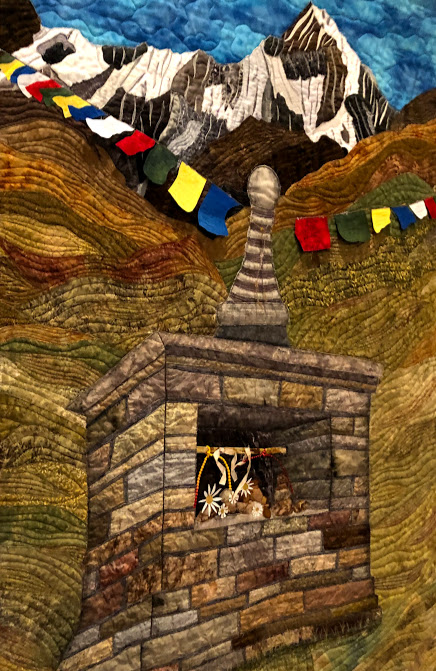
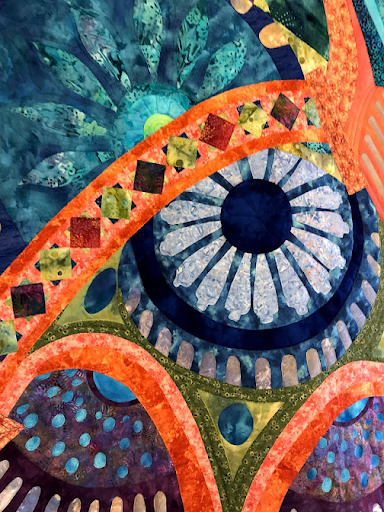
Arnold’s interest in quilting, much like her preferences on how to do it, differed from her mother’s.
“She honestly never really understood the quilts that I made, because they were just so very different,” Arnold said.
However, Arnold and her mother found enough common ground to share quilting projects.
They worked together on quilting projects as Arnold’s mother aged — Arnold using machine stitching and fabric fusing, and her mother stitching by hand.
“And she was so fast I couldn’t keep up with her,” Arnold said.

One of the finished products is a quilt with wide square blocks containing funky, colorful floral patterns, each one surrounded by long strips of blue, teal and orange.
“It was really a lot of fun, and I love that we have these quilts,” Arnold said. “We have another one that we had started before she passed away. I’ll have to finish that one day.”
As for Arnold’s own children, they’ve yet to take up quilting the way she has, but they, like Arnold, have learned enough from their mother to take up the practice later if they decide to.
If one thing is for sure, it’s that the practice of quilting — and what draws people to it — continues to change.
For Schaefer, it was the chance to express her love of crafting and of science. For Campbell, it was the drive to run her own business. For Arnold, it was the ability to do with thread and cloth what others do with paints and pencils.
It could be any of these things — or none of them — that drive the next generation of quilters to keep up the practice. Whatever their motivation, however, it seems they will have qualified and passionate teachers to learn from.
Mara Nelms is a fourth-year majoring in journalism in the Grady College of Journalism and Mass Communication at the University of Georgia.










